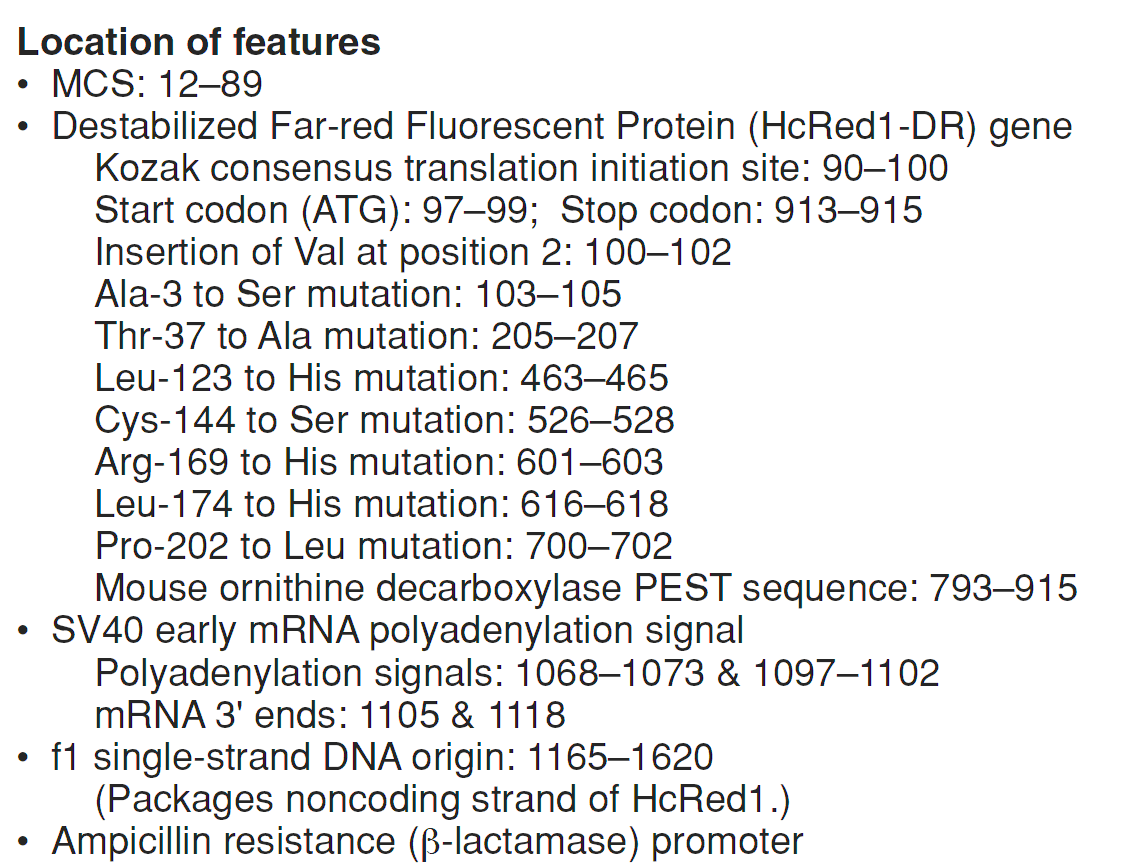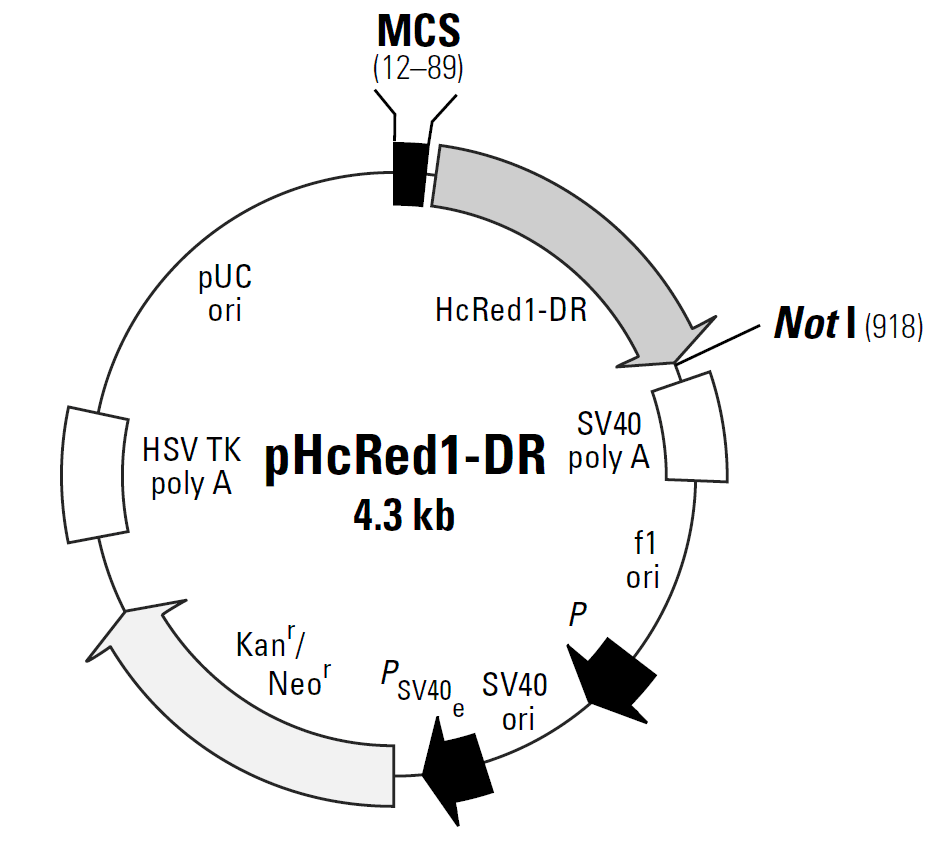pHcRed1-DR
pHcRed1-DR
编号 | 载体名称 |
北京华越洋VECT75329 | pHcRed1-DR |
pHcRed1-DR载体基本信息:
载体名称: | pHcRed1-DR |
质粒类型: | 无启动子载体;荧光报告载体 |
高拷贝/低拷贝: | 高拷贝 |
克隆方法: | 限制性内切酶,多克隆位点 |
启动子: | 无启动子 |
载体大小: | 4.3 kb |
5' 测序引物及序列: | -- |
3' 测序引物及序列: | -- |
载体标签: | 红色荧光蛋白HcRed1-DR(C-端) |
载体抗性: | 卡那霉素 |
筛选标记: | Neomycin_1.html' target='_blank'>新霉素(Neomycin) |
克隆菌株: | TOP10, DH5α, HB101 |
宿主细胞(系): | 真核细胞 |
备注: | pHcRed1-DR载体含有红色荧光报告基因; |
稳定性: | 瞬表达 或 稳表达 |
组成型/诱导型: | -- |
病毒/非病毒: | 非病毒 |
pHcRed1-DR载体质粒图谱和多克隆位点信息:



pHcRed1-DR载体描述:
pHcRed1-DR is a promoterless vector that encodes HcRed1-DR, a destabilized variant of Living Colors far-red fluorescent protein, HcRed1 (1). In contrast to the original protein, HcRed1-DR has a short half-life, making it well suited for studies that require rapid reporter turnover. HcRed1-DR was generated from HcRed1 by fusing the C-terminus of the protein to amino acid residues 422–461 of mouse ornithine decarboxylase (MODC), one of the most short-lived proteins in mammalian cells (2). This region of MODC contains a PEST sequence that targets the protein for degradation, resulting in rapid protein turnover (2, 3). The original protein, HcRed1, whose excitation and emission maxima occur at 588 nm and 618 nm ±4 nm, was generated by mutagenesis of a non-fluorescent chromoprotein from the reef coral Heteractis crispa (4; HcRed-2A). The HcRed1-DR coding sequence has been human codon-optimized for higher expression in mammalian cells (5). Sequences upstream of the HcRed1 coding sequence have been converted to a Kozak consensus translation initiation site (6) to increase the translation efficiency in eukaryotic cells.
pHcRed1-DR can be used to monitor transcription from different promoters and promoter/enhancer combinations inserted into the multiple cloning site (MCS), located upstream of the HcRed1-DR coding sequence. SV40 polyadenylation signals downstream of the HcRed1-DR gene direct proper processing of the 3' end of the HcRed1-DR mRNA. The vector also contains an SV40 origin for replication in mammalian cells expressing the SV40 large T antigen. A neomycin-resistance cassette (Neor) allows stably transfected eukaryotic cells to be selected using G418 (4). The Neor cassette consists of the SV40 early promoter, the neomycin/kanamycin resistance gene of Tn5, and polyadenylation signals from the Herpes simplex virus thymidine kinase (HSV TK) gene. A bacterial promoter upstream of this cassette confers kanamycin resistance in E. coli. pHcRed1-DR also provides a pUC origin of replication for propagation in E. coli and an f1 origin for single-stranded DNA production.
HcRed1-DR can be used as an in vivo reporter of gene expression. Because of its rapid turnover rate, its expression from a promoter of interest provides a more accurate assessment of the promoter's activity over time than does the more stable HcRed1. Promoter/enhancer elements should be inserted into the MCS upstream of the HcRed1-DR coding sequences. Without the addition of a functional promoter, this vector will not express HcRed1-DR. The recombinant pHcRed1-DR vector can be transfected into mammalian cells using any standard transfection method. If required, stable transformants can be selected using G418 (7).
pHcRed1-DR载体含有以下元件:
MCS: 12–89
Destabilized Far-red Fluorescent Protein (HcRed1-DR) gene
Kozak consensus translation initiation site: 90–100
Start codon (ATG): 97–99; Stop codon: 913–915
Insertion of Val at position 2: 100–102
Ala-3 to Ser mutation: 103–105
Thr-37 to Ala mutation: 205–207
Leu-123 to His mutation: 463–465
Cys-144 to Ser mutation: 526–528
Arg-169 to His mutation: 601–603
Leu-174 to His mutation: 616–618
Pro-202 to Leu mutation: 700–702
Mouse ornithine decarboxylase PEST sequence: 793–915
SV40 early mRNA polyadenylation signal
Polyadenylation signals: 1068–1073 & 1097–1102
mRNA 3' ends: 1105 & 1118
f1 single-strand DNA origin: 1165–1620
(Packages noncoding strand of HcRed1.)
Ampicillin resistance (β-lactamase) promoter
–35 region: 1682–1687; –10 region: 1705–1710
Transcription start point: 1717
SV40 origin of replication: 1961–2096
SV40 early promoter
Enhancer (72-bp tandem repeats): 1792–1865 & 1866–1937
21-bp repeats: 1941–1961, 1962–1982 & 1984–2004
Early promoter element: 2017–2023
Major transcription start points: 2013, 2051, 2057 & 2062
Kanamycin/neomycin resistance geneNeomycin phosphotransferase coding sequences:
Start codon (ATG): 2145–2147; stop codon: 2937–2939
G→A mutation to remove Pst I site: 2327
C→A (Arg→Ser) mutation to remove BssH II site: 2673
Herpes simplex virus (HSV) thymidine kinase (TK) polyadenylation signal
Polyadenylation signals: 3175–3180 & 3188–3193
pUC plasmid replication origin: 3524–4170
pHcRed1-DR载体其他相关的其他类型载体:


